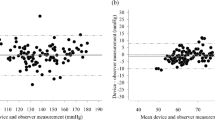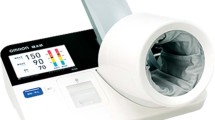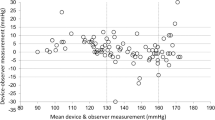Abstract
Oscillometric devices are being widely used for ambulatory, home and office blood pressure (BP) measurement. However, even successfully validated oscillometric devices fail to provide accurate measurements in some patients. This study investigated the prevalence, the reproducibility and the characteristics of the phenomenon of unreliable oscillometric BP (UOBP) measurement. A total of 5070 BP measurements were obtained simultaneously (Y connector) using a professional oscillometric device (BpTRU) and a mercury sphygmomanometer in 755 patients (1706 visits). UOBP readings were defined as those with >10 mm Hg difference (systolic or diastolic) between the two methods. UOBP was found in 15% of systolic and 6.4% of diastolic BP measurements. In all, 18% of the participants had UOBP in their first but not their second visit, or the reverse. However, 49% of these participants had at least one more UOBP visit after their second visit within the study database. Patients with persistent UOBP were more likely to be female and had lower arm circumference. The systolic BP discrepancy between the two methods was associated with pulse pressure (r=0.41) and inversely with diastolic BP (r=0.40) and arm circumference (r=0.30), whereas the diastolic discrepancy with diastolic BP (r=0.61) and inversely with pulse pressure (r=0.32). There was a consistent significant trend for larger systolic BP discrepancy and smaller diastolic from the lower to the higher pulse pressure quintile (P<0.0001). A decreasing arm circumference was a significant predictor of persistent UOBP. These data suggest that the UOBP measurement is particularly common, not very reproducible and mainly affected by pulse pressure and arm circumference.
This is a preview of subscription content, access via your institution
Access options
Subscribe to this journal
Receive 12 digital issues and online access to articles
$119.00 per year
only $9.92 per issue
Buy this article
- Purchase on Springer Link
- Instant access to full article PDF
Prices may be subject to local taxes which are calculated during checkout


Similar content being viewed by others
References
O'Brien E, Asmar R, Beilin L, Imai Y, Mallion JM, Mancia G et al. European Society of Hypertension Working Group on Blood Pressure Monitoring. European Society of Hypertension recommendations for conventional, ambulatory and home blood pressure measurement. J Hypertens 2003; 21: 821–848.
Pickering TG, Hall JE, Appel LJ, Falkner BE, Graves J, Hill MN et al. Subcommittee of Professional and Public Education of the American Heart Association Council on High Blood Pressure Research. Recommendations for blood pressure measurement in humans and experimental animals: Part 1: blood pressure measurement in humans: a statement for professionals from the Subcommittee of Professional and Public Education of the American Heart Association Council on High Blood Pressure Research. Hypertension 2005; 45: 142–161.
Pickering TG, Miller NH, Ogedegbe G, Krakoff LR, Artinian NT, Goff D . American Heart Association; American Society of Hypertension; Preventive Cardiovascular Nurses Association. Call to action on use and reimbursement for home blood pressure monitoring: a joint scientific statement from the American Heart Association, American Society Of Hypertension, and Preventive Cardiovascular Nurses Association. Hypertension 2008; 52: 10–29.
Parati G, Stergiou GS, Asmar R, Bilo G, de Leeuw P, Imai Y et al. ESH Working Group on Blood Pressure Monitoring. European Society of Hypertension guidelines for blood pressure monitoring at home: a summary report of the Second International Consensus Conference on Home Blood Pressure Monitoring. J Hypertens 2008; 26: 1505–1526.
Pickering TG . What will replace the mercury sphygmomanometer? Blood Press Monit 2003; 8: 23–25.
Stergiou GS . Office blood pressure measurement with electronic devices: has the time come? Am J Hypertens 2008; 21: 246.
White WB, Berson AS, Robbins C, Jamieson MJ, Prisant LM, Roccella E et al. National standard for measurement of resting and ambulatory blood pressures with automated sphygmomanometers. Hypertension 1993; 21: 504–509.
O'Brien E, Petrie J, Littler W, de Swiet M, Padfield PL, O'Malley K et al. The British Hypertension Society protocol for the evaluation of automated and semi-automated blood pressure measuring devices with special reference to ambulatory systems. J Hypertens 1990; 8: 607–619.
O'Brien E, Pickering T, Asmar R, Myers M, Parati G, Staessen J, et al., On behalf of the Working Group on Blood Pressure Monitoring of the European Society of Hypertension Working Group on Blood Pressure Monitoring of the European Society of Hypertension. International Protocol for validation of blood pressure measuring devices in adults. Blood Press Monit 2002; 7: 3–17.
dabl® Educational Trust. Devices for blood pressure measurement. http://www.dableducational.org. Assessed 2 November 2008.
O'Brien E, Atkins N . Validation and reliability of blood pressure monitors. In: W White (ed). Blood Press Monit Cardiovasc Med Ther. Humana Press Inc.: Totowa, NJ, USA, 2007, pp 97–132.
Gerin W, Schwartz AR, Schwartz JE, Pickering TG, Davidson KW, Bress J et al. Limitations of current validation protocols for home blood pressure monitors for individual patients. Blood Press Monit 2002; 7: 313–318.
Wright JM, Mattu GS, Perry Jr TL, Gelferc ME, Strange KD, Zorn A et al. Validation of a new algorithm for the BPM-100 electronic oscillometric office blood pressure monitor. Blood Press Monit 2001; 6: 161–165.
Mattu GS, Perry Jr TL, Wright JM . Comparison of the oscillometric blood pressure monitor (BPM-100 (Beta)) with the auscultatory mercury sphygmomanometer. Blood Press Monit 2001; 6: 153–159.
Pickering TG, Hall JE, Appel LJ, Falkner BE, Graves J, Hill MN et al. Subcommittee of Professional and Public Education of the American Heart Association Council on High Blood Pressure Research. Recommendations for blood pressure measurement in humans and experimental animals: Part 1: blood pressure measurement in humans: a statement for professionals from the Subcommittee of Professional and Public Education of the American Heart Association Council on High Blood Pressure Research. Hypertension 2005; 45: 142–161.
Viera AJ, Garrett JM . Understanding interobserver agreement: the kappa statistic. Fam Med 2005; 37: 360–363.
Stergiou GS, Alamara CV, Salgami EV, Vaindirlis IN, Dacou-Voutetakis C, Mountokalakis TD . Reproducibility of home and ambulatory blood pressure in children and adolescents. Blood Press Monit 2005; 10: 143–147.
Van Popele NM, Bos WJ, de Beer NA, van Der Kuip DA, Hofman A, Grobbee DE et al. Arterial stiffness as underlying mechanism of disagreement between an oscillometric blood pressure monitor and a sphygmomanometer. Hypertension 2000; 36: 484–488.
Ni H, Wu C, Prineas R, Shea S, Liu K, Kronmal R et al. Comparison of Dinamap PRO-100 and mercury sphygmomanometer blood pressure measurements in a population-based study. Am J Hypertens 2006; 19: 353–360.
Van Ittersum FJ, Wijering RM, Lambert J, Donker AJ, Stehouwer CD . Determinants of the limits of agreement between the sphygmomanometer and the SpaceLabs 90207 device for blood pressure measurement in healthy volunteers and insulin-dependent diabetic patients. J Hypertens 1998; 16: 1125–1130.
Thompson AM, Eguchi K, Reznik ME, Shah SS, Pickering TG . Validation of an oscillometric home blood pressure monitor in an end-stage renal disease population and the effect of arterial stiffness on its accuracy. Blood Press Monit 2007; 12: 227–232.
Stergiou GS, Yiannes NG, Rarra VC . Validation of the Omron 705 IT oscillometric device for home blood pressure measurement in children and adolescents: the Arsakion School Study. Blood Press Monit 2006; 11: 229–234.
Author information
Authors and Affiliations
Corresponding author
Rights and permissions
About this article
Cite this article
Stergiou, G., Lourida, P., Tzamouranis, D. et al. Unreliable oscillometric blood pressure measurement: prevalence, repeatability and characteristics of the phenomenon. J Hum Hypertens 23, 794–800 (2009). https://doi.org/10.1038/jhh.2009.20
Received:
Revised:
Accepted:
Published:
Issue Date:
DOI: https://doi.org/10.1038/jhh.2009.20
Keywords
This article is cited by
-
Automated ‘oscillometric’ blood pressure measuring devices: how they work and what they measure
Journal of Human Hypertension (2022)
-
Cuff Under Pressure for Greater Accuracy
Current Hypertension Reports (2020)
-
Hypertension Prevalence and Control: Impact of Method of Blood Pressure Measurement
Current Cardiovascular Risk Reports (2012)
-
Replacing the mercury manometer with an oscillometric device in a hypertension clinic: implications for clinical decision making
Journal of Human Hypertension (2011)
-
Short and longer term repeatability of ballistocardiography in a sitting position with EMFi sensor
Medical & Biological Engineering & Computing (2011)



